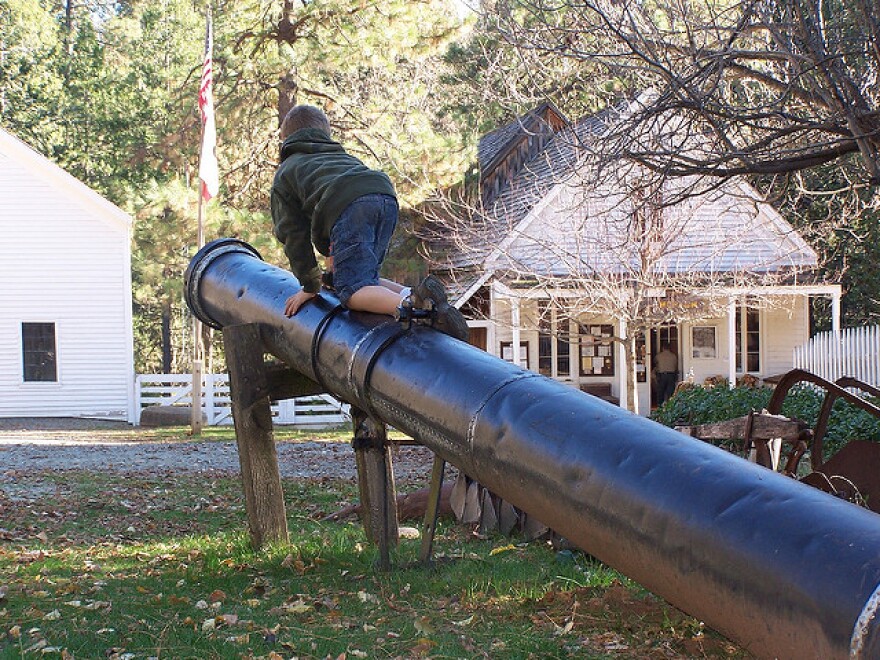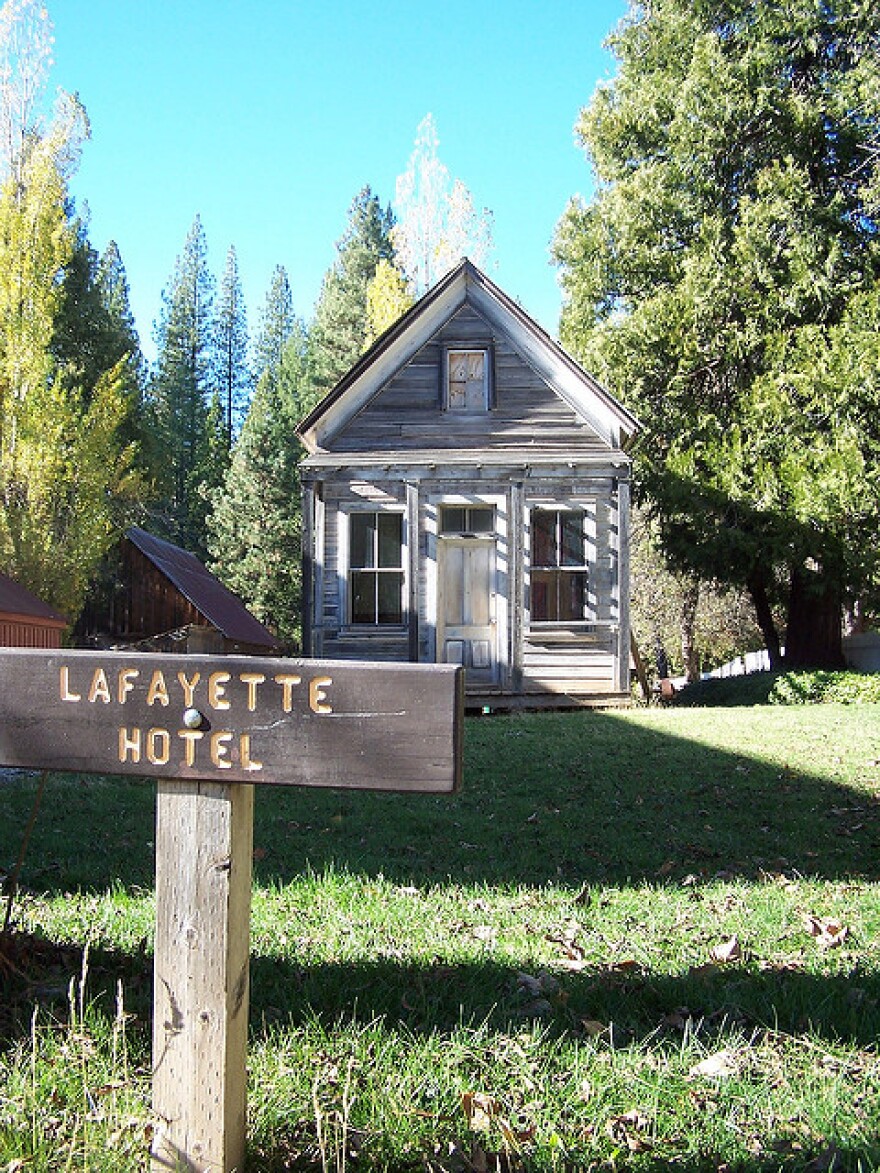Last time we talked about California’s contemporary creation story, the fictional tale that helped create the richest state in the United States. Native American stories about how this world came to be were much better, stunningly mystical, and more poetic. But a 16th-century Spanish novel about the island paradise of California, a land of gold, precious gems, and beautiful black women ruled by the great Queen Calafia, was the fantady that fired up European imaginations and inspired explorer Hernan Cortes’ crew to name this place California.
Spanish explorers never found the gold, but it was here. The Americans found it, in 1849, in the Sierra Nevada’s western foothills. It’s no coincidence that California became a state very soon after, the following year. The United States wanted the gold—and would use it to create and finance the Union Army in the Civil War to come.
It’s a challenge to fully explore the hundreds of miles where the gold rush officially rushed. So you need a plan, or a particular focus, to guide you. Some possibilities—most of which we’ll explore in the next few weeks—include wine grapes and other produce; railroading and other transportation history; mining technologies; hotels and history; and rip-snortin’ recreation.

This week we’ll look into 1850s’ mining technologies, because getting the gold was priority one. The process wasn’t nearly as pretty or peaceful as a present-day tour might suggest. The need to get to that gold as fast and efficiently as possible drove technological innovation as well as social and environmental chaos.
The first gold hunters merely scratched the surface, sloshing through foothill streams and rivers to pan for that telltale color. Placer miners scooped up dirt, gravel, and sand, and using broad, finely woven Native American baskets or shallow metal pans, swirled the watery slurry round and round, looking for the gold flakes nature had already mined. Gold was heavier than sand or pebbles of similar size. Yet miners quickly discovered they could hit pay dirt faster if they used larger rockers and cradles to process the murky gold-rich slurry.
Another early innovation was the “long tom,” or a small version of the later sluice box, a shallow wooden trough 12 to 24 feet long connected at the lower end to a sieve-covered “ripple-box” where the gold collected. The long tom’s upper end was usually inserted into a dam, ditch, or flume, to take advantage of water flow and gravity. At the end of the day, miners panned the contents of the ripple-box, where heavier gold particles ended up. You’ll see examples of these technologies at museums throughout the region.
Sluicing meant greater productivity but also required steady supplies of water, not naturally available during summer or autumn. So massive wooden flumes—seen everywhere throughout the gold country today—were built to deliver water from year-round mountain streams to dry areas. Construction of these flumes required considerable capital investment and encouraged the formation of mining companies, then corporations.
By the early 1850s, foothill rivers and streams had been picked clean. Next came hydraulic mining, which used huge rawhide firehoses and one-ton iron nozzles called “monitors” as water cannons to blast water against hillsides, exposing placer gravel and gold, yes, but destroying the land and creating muddy runoff and sediment or “slickens” that killed streamlife and ruined downstream farmland.

This technique created the weirdly beautiful landscape—preserved today at very remote Malakoff Diggins State Historic Park some 26 miles north then east of Nevada City, a great place to pitch a tent or overnight in one of the park’s rustic cabins. Hydraulic mining scoured the area into barren, colorful spires haunted by the spirit of Utah’s Bryce Canyon. The ghoulish moonscape is as ecologically horrifying as it is seductive. Miles of trails below San Juan Ridge cut through the otherworldly terrain. While wandering them you may find yourself musing that sure, enlightened thinking may move mountains, but greed can do it too. Here’s the proof.
The scoured rocks near Columbia, a well-preserved town that’s a state historic park and National Historic Landmark District in its entirety, also testify to hydraulic mining’s lasting impacts. Sediments from hydraulic mining filled in about one-third of San Francisco Bay during a 10-year period. Outraged downstream landowners, including California’s powerful railroad lobby, petitioned the courts for relief and won. Hydraulic mining was banned in 1883, marking the first major U.S. political victory on behalf of the environment.
But during the gold rush drunken bar brawls, shady ladies, and muddy, manure-filled streets defined daily life in Columbia, the “Gem of the Southern Mines.” First known as American Camp, Columbia served as capital city to an area population of more than 15,000 in its prime. But in 1854 the town lost the scuffle for state capital to Sacramento by just two legislative votes—a devastating political loss for the biggest, richest, and wickedest gold town of them all. Even before its painstaking restoration, the former American Camp was the most beautifully preserved of all gold country towns. Quite a few Westerns, including High Noon and scenes from Clint Eastwood’s The Unforgiven, have been filmed there.
But back to mining technology: When the surface gold was gone, the search went deeper. Hardrock mining, with shafts mechanically hammered into and under mountains, helped along by the 1860 invention of dynamite. As hardrock mining was only feasible with large infusions of capital, this method and big business arrived hand in hand. Remnants of hardrock mines are found throughout today’s gold country, the best place to get the big picture is Empire Mine State Historic Park in Grass Valley.

English miners from Cornwall, called “cousin Jacks,” worked this mine complex on Gold Hill, one of the oldest and most profitable hardrock mines in the state. In business for more than 100 years, the Empire’s 367 miles of tunnels reluctantly yielded millions of ounces of gold; it’s estimated that four times as much is still there, too expensive to dig out.
After mining crews working with pickaxes and shovels separated the gold-bearing quartz ore from bedrock, they hauled it to the surface in mule-driven carts. To crush the rock and free the gold, mule-powered Mexican arrastra was first used, a device similar to a giant mortar with a drag-stone pestle.
More efficient, though, were the deafening stamp mills that soon loomed up, as tall as two-story hotels, all around gold rush towns. The pistonlike stamps quickly pulverized the stone, then the gold was separated through amalgamation with mercury; at temperatures of 2,600° F, the mercury vaporized and the molten gold was ready for pouring into ingots.
The only place to see a fully functional stamp mill in action is just outside Sierra City’s Old Kentucky Mine, the community’s beautifully preserved historic park with the original machinery still intact. Open seasonally for two daily tours—complete with loudly pounding stamps—the Sierra City Historical Society’s Kentucky Mine Historic Park and Museum includes a modern amphitheater that hosts Music at the Mine and other events. The excellent museum is a rebuilt version of Sierra City’s old Bigelow House hotel. Best of all are the mine itself, which produced some $8 billion in its day, and the six-story stamp mill, the only original, fully operable one available for tours. The system here included a Pelton wheel, an air compressor for dynamite drilling, and a mammoth mill operation with jawlike ore crushers and stamps.




